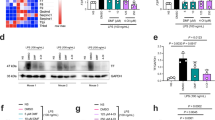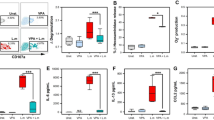Abstract
As the most prominent clinical drug targets for the inhibition of platelet aggregation, P2Y12 and P2Y13 have been found to be highly expressed in both platelets and macrophages. However, the roles and function of P2Y12/13 in the regulation of macrophage-mediated innate immune responses remain unclear. Here, we demonstrate that adenosine 5′-diphosphate (ADP), the endogenous ligand of P2Y1, P2Y12 and P2Y13, was released both in E. coli-infected mice and from macrophages treated with either lipopolysaccharide (LPS) or Pam3CSK4. Furthermore, the expression of P2Y13 was clearly increased in both LPS-treated macrophages and tuberculosis patients. ADP protected mice from E. coli 0111-induced peritonitis by recruiting more macrophages to the infected sites. Consistent with this, ADP and ADP-treated cell culture medium attracted more macrophages in the transwell assay by enhancing the expression of MCP-1. Nevertheless, P2Y1 is dispensable for ADP-mediated protection against bacterial infection. However, either P2Y12/P2Y13 deficiency or blocking the downstream signaling of P2Y12/P2Y13 blocked the ADP-mediated immune response and allowed more bacteria to persist in the infected mice. Furthermore, extracellular signal-regulated kinase (ERK) phosphorylation was clearly increased by ADP, and this type of activation could be blocked by either forskolin or analogs of cyclic AMP (cAMP) (for example, 8-bromo-cAMP). Accordingly, ADP-induced MCP-1 production and protection against bacterial infection could also be reduced by U0126, forskolin and 8-bromo-cAMP. Overall, our study reveals a relationship between danger signals and innate immune responses, which suggests the potential therapeutic significance of ADP-mediated purinergic signaling in infectious diseases.
This is a preview of subscription content, access via your institution
Access options
Subscribe to this journal
Receive 12 digital issues and online access to articles
$119.00 per year
only $9.92 per issue
Buy this article
- Purchase on Springer Link
- Instant access to full article PDF
Prices may be subject to local taxes which are calculated during checkout










Similar content being viewed by others
References
Janeway CA, Medzhitov R . Innate immune recognition. Ann Rev Immunol 2002; 20: 197–216.
Medzhitov R . Recognition of microorganisms and activation of the immune response. Nature 2007; 449: 819–826.
Pedra JHF, Cassel SL, Sutterwala FS . Sensing pathogens and danger signals by the inflammasome. Curr Opin Immunol 2009; 21: 10–16.
Paoletti A, Raza SQ, Voisin L, Law F, Pipoli da Fonseca J, Caillet M et al. Multifaceted roles of purinergic receptors in viral infection. Microbes Infect 2012; 14: 1278–1283.
Tang D, Kang R, Coyne CB, Zeh HJ, Lotze MT . PAMPs and DAMPs: signal 0s that spur autophagy and immunity. Immunol Rev 2012; 249: 158–175.
Ralevic V, Burnstock G . Receptors for purines and pyrimidines. Pharmacol Rev 1998; 50: 413–492.
Chen Y, Corriden R, Inoue Y, Yip L, Hashiguchi N, Zinkernagel A et al. ATP release guides neutrophil chemotaxis via P2Y2 and A3 receptors. Science 2006; 314: 1792–1795.
Bednash JS, Mallampalli RK . Regulation of inflammasomes by ubiquitination. Cell Mol Immunol 2016.
Jo EK, Kim JK, Shin DM, Sasakawa C . Molecular mechanisms regulating NLRP3 inflammasome activation. Cell Mol Immunol 2016; 13: 148–159.
Ren H, Teng Y, Tan B, Zhang X, Jiang W, Liu M et al. Toll-like receptor-triggered calcium mobilization protects mice against bacterial infection through extracellular ATP release. Infect Immun 2014; 82: 5076–5085.
Gendron FP, Benrezzak O, Krugh BW, Kong Q, Weisman GA, Beaudoin AR . Purine signaling and potential new therapeutic approach: possible outcomes of NTPDase inhibition. Curr Drug Targets 2002; 3: 229–245.
Yegutkin GG . Nucleotide- and nucleoside-converting ectoenzymes: Important modulators of purinergic signalling cascade. Biochim Biophys Acta 2008; 1783: 673–694.
Paruchuri S, Tashimo H, Feng C, Maekawa A, Xing W, Jiang Y et al. Leukotriene E4-induced pulmonary inflammation is mediated by the P2Y12 receptor. J Exp Med 2009; 206: 2543–2555.
Woodford N, Turton JF, Livermore DM . Multiresistant Gram-negative bacteria: the role of high-risk clones in the dissemination of antibiotic resistance. FEMS Microbiol Rev 2011; 35: 736–755.
Hawkey PM, Jones AM . The changing epidemiology of resistance. J Antimicrob Chemother 2009; 64: i3–i10.
Cai Y, Yang Q, Tang Y, Zhang M, Liu H, Zhang G et al. Increased complement C1q level marks active disease in human tuberculosis. PLoS One 2014; 9: e92340.
Qin J, Zhang G, Zhang X, Tan B, Lv Z, Liu M et al. TLR-activated gap junction channels protect mice against bacterial infection through extracellular UDP release. J Immunol 2016; 196: 1790–1798.
Topol EJ, Schork NJ . Catapulting clopidogrel pharmacogenomics forward. Nat Med 2011; 17: 40–41.
Chen YG, Xu F, Zhang Y, Ji QS, Sun Y, Lu RJ et al. Effect of aspirin plus clopidogrel on inflammatory markers in patients with non-ST-segment elevation acute coronary syndrome. Chin Med J 2006; 119: 32–36.
Gurbel PA, Bliden KP, Tantry US . Effect of clopidogrel with and without eptifibatide on tumor necrosis factor-alpha and C-reactive protein release after elective stenting: results from the clear platelets 1b study. J Am Coll Cardiol 2006; 48: 2186–2191.
Bours MJ, Swennen EL, Di Virgilio F, Cronstein BN, Dagnelie PC . Adenosine 5'-triphosphate and adenosine as endogenous signaling molecules in immunity and inflammation. Pharmacol Ther 2006; 112: 358–404.
Li R, Tan B, Yan Y, Ma X, Zhang N, Zhang Z et al. Extracellular UDP and P2Y6 function as a danger signal to protect mice from vesicular stomatitis virus infection through an increase in IFN-beta production. J Immunol 2014; 193: 4515–4526.
Woulfe D, Yang J, Brass L . ADP and platelets: the end of the beginning. J Clin Invest 2001; 107: 1503–1505.
Hasko G, Linden J, Cronstein B, Pacher P . Adenosine receptors: therapeutic aspects for inflammatory and immune diseases. Nat Rev Drug Discov 2008; 7: 759–770.
Najar HM, Ruhl S, Bru-Capdeville AC, Peters JH . Adenosine and its derivatives control human monocyte differentiation into highly accessory cells versus macrophages. J Leukoc Biol 1990; 47: 429–439.
Haskó G, Kuhel DG, Chen J-F, Schwarzschild MA, Deitch EA, Mabley JG et al. Adenosine inhibits IL-12 and TNF-α production via adenosine A2a receptor-dependent and independent mechanisms. FASEB J 2000; 14: 2065–2074.
van Furth R, Cohn ZA . The origin and kinetics of mononuclear phagocytes. J Exp Med 1968; 128: 415–435.
Serbina NV, Jia T, Hohl TM, Pamer EG . Monocyte-mediated defense against microbial pathogens. Annu Rev Immunol 2008; 26: 421–452.
Woollard KJ, Geissmann F . Monocytes in atherosclerosis: subsets and functions. Nat Rev Cardiol 2010; 7: 77–86.
Kurihara T, Warr G, Loy J, Bravo R . Defects in macrophage recruitment and host defense in mice lacking the CCR2 chemokine receptor. J Exp Med 1997; 186: 1757–1762.
Kuziel WA, Morgan SJ, Dawson TC, Griffin S, Smithies O, Ley K et al. Severe reduction in leukocyte adhesion and monocyte extravasation in mice deficient in CC chemokine receptor 2. Proc Natl Acad Sci USA 1997; 94: 12053–12058.
Auffray C, Fogg D, Garfa M, Elain G, Join-Lambert O, Kayal S et al. Monitoring of blood vessels and tissues by a population of monocytes with patrolling behavior. Science 2007; 317: 666–670.
Nahrendorf M, Swirski FK, Aikawa E, Stangenberg L, Wurdinger T, Figueiredo JL et al. The healing myocardium sequentially mobilizes two monocyte subsets with divergent and complementary functions. J Exp Med 2007; 204: 3037–3047.
Mosenden R, Tasken K . Cyclic AMP-mediated immune regulation—overview of mechanisms of action in T cells. Cell Signal 2011; 23: 1009–1016.
Zhu N, Cui J, Qiao C, Li Y, Ma Y, Zhang J et al. cAMP modulates macrophage development by suppressing M-CSF-induced MAPKs activation. Cell Mol Immunol 2008; 5: 153–157.
Vitiello L, Gorini S, Rosano G, la Sala A . Immunoregulation through extracellular nucleotides. Blood 2012; 120: 511–518.
Acknowledgements
This work was supported by the National Basic Research Program of China (2012CB910400), the National Natural Science Foundation of China (81272369, 31470040, 31570896 and 81672811), the Doctoral Fund of Ministry of Education of China (20130076110013); Science and Technology Commission of Shanghai Municipality (15JC1401500).
Author information
Authors and Affiliations
Corresponding author
Ethics declarations
Competing interests
The authors declare no conflict of interest.
Rights and permissions
About this article
Cite this article
Zhang, X., Qin, J., Zou, J. et al. Extracellular ADP facilitates monocyte recruitment in bacterial infection via ERK signaling. Cell Mol Immunol 15, 58–73 (2018). https://doi.org/10.1038/cmi.2016.56
Received:
Revised:
Accepted:
Published:
Issue Date:
DOI: https://doi.org/10.1038/cmi.2016.56
Keywords
This article is cited by
-
Macrophages reprogramming improves immunotherapy of IL-33 in peritoneal metastasis of gastric cancer
EMBO Molecular Medicine (2024)
-
Extracellular adenosine 5ʹ-diphosphate promotes MCP-1/CCL2 expression via the P2Y13 purinergic receptor/ERK signaling axis in temporomandibular joint-derived mouse fibroblast-like synoviocytes
Molecular Biology Reports (2023)
-
Inflammatory macrophages exacerbate neutrophil-driven joint damage through ADP/P2Y1 signaling in rheumatoid arthritis
Science China Life Sciences (2022)
-
Purinergic modulation of the immune response to infections
Purinergic Signalling (2022)
-
ADP/P2Y1 aggravates inflammatory bowel disease through ERK5-mediated NLRP3 inflammasome activation
Mucosal Immunology (2020)



